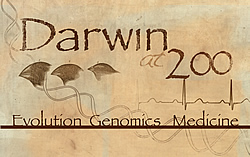Last updated: August 29, 2012
Darwin at 200: How Geneticists View Him Today
Darwin at 200: How Geneticists View Him Today
February 12, 2009, marked the 200th birthday of Charles Darwin (1809-1882) and the 150th year since publication of his seminal work, On the Origin of Species. The renowned 19th century naturalist made observations on plant and animal life that set science on a new course, introducing evolution as the unifying concept in all of genetics and biology. Students of U.S. history will note that the date is also the 200th birthday of U.S. President Abraham Lincoln.The National Human Genome Research Institute (NHGRI) observed Darwin's life and accomplishments at events at the NIH's Bethesda campus and at the Smithsonian Institution's National Museum of Natural History. Hear what geneticists at NHGRI have to say about Darwin's ideas, science and legacy.
![]() Watch Darwin at 200: How Geneticists View Him Today
Watch Darwin at 200: How Geneticists View Him Today
Darwin at 200: Evolution, Genomics, Medicine: Program Agenda

Darwin at 200: Evolution, Genomics, Medicine was a symposium that celebrated the 200th anniversary of the birth of Charles Darwin from 8:30 a.m. - 12:30 p.m., Thursday, Feb. 12, 2009. The symposium was held at Masur Auditorium, NIH Campus, Bethesda, Md.
Speakers included NHGRI Acting Director Alan Guttmacher, M.D., and Scientific Director Eric Green, M.D., Ph.D., among other celebrated researchers from across the country.
Watch Darwin at 200: Evolution, Genomics, Medicine [videocast.nih.gov]
NHGRI's presentation of speakers held at Masur Auditorium, NIH Campus on February 12, 2009.
Program Agenda
8:30 a.m. – Welcome: Alan Guttmacher, M.D., Acting Director, NHGRI8:35 - 8:45 a.m. – Opening Remarks: Eric Green, M.D., Ph.D., Scientific Director, NHGRI
8:45 - 9:15 a.m. – Darwin's Quest for Human Origins: Donald Johanson, Ph.D., Arizona State University
9:15 - 9:45 a.m. – The Genetic and Genomic Basis of Evolutionary Change in Vertebrates: David Kingsley, Ph.D., Howard Hughes Medical Institute
9:45 - 10:15 a.m. – Algorithmic Reconstruction of Genome Evolution: David Haussler, Ph.D., Howard Hughes Medical Institute
10:15 - 10:45 a.m. – Break
10:45 - 11:15 a.m. – The Long and Short of It: Finding the Genes Controlling Canine Morphological Traits: Elaine Ostrander, Ph.D., Chief, Cancer Genetics Branch, NHGRI
11:15 - 11:45 a.m. – Sialic Acids: A "Hotspot" in Human Evolution and Medicine?: Ajit Varki, M.D., University of California, San Diego
11:45 a.m. - 12:15 p.m. – Recent Evolutionary Adaptations in the Human Lineage: Pardis Sabeti, M.D., Ph.D., Harvard FAS Center for Systems Biology
12:15 p.m. – Closing Remarks: Eric Green, M.D., Ph.D.
Public and High School Program
The Darwin @ 200 Anniversary Celebration was a program offered by NHGRI and the Smithsonian Institution's National Museum of Natural History. High school students from the Washington metropolitan region gathered for a program featuring a distinguished panel of speakers on a variety of topics, from historical perspectives of Darwin, to evolution and medicine.
Among the featured speakers wer paleoanthropologist Donald C. Johanson, who discovered fossils of early hominid species, including the skeleton of a 3.5 million-year-old female hominid, known as Lucy.
Speakers from NHGRI included Acting Director Alan Guttmacher, M.D. and Former Director Francis Collins, M.D., Ph.D. The program was held fro 12 - 3 p.m. at the Baird Auditorium, National Museum of Natural History, located at the intersection of 10th Street and Constitution Avenue, NW, Washington, D.C. The event was open to the public.
Galapagos Photography Exhibit
NIH Clinical Center is featuring photographs of the Galapagos Islands in an exhibit running now through February 26, 2009. Photos of the island where Darwin conducted essential fieldwork, with its unique and diverse flora and fauna, were submitted by NIH employees and patients, as well as photographers from the community. NHGRI Scientific Director Eric Green, M.D., Ph.D. is among the NIH photographers whose work is now on display in the East Gallery and East Alcove Gallery on the first floor of the Mark O. Hatfield Clinical Research Center, NIH Campus, Bethesda, Md.

